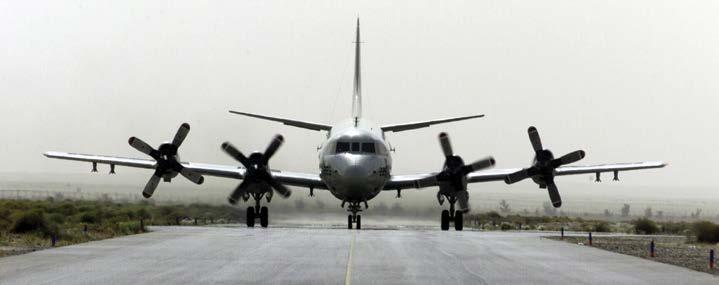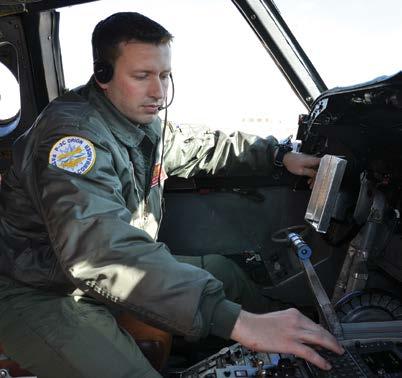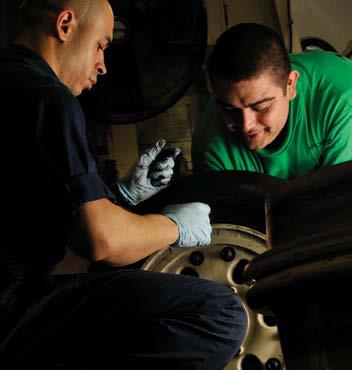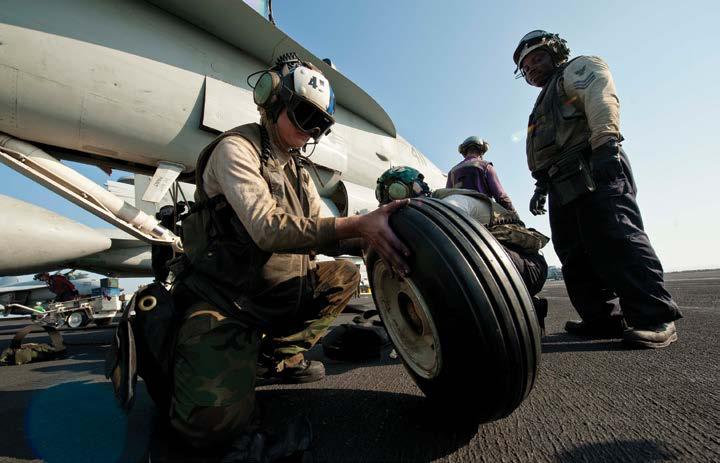
17 minute read
What Five Aviators Missed
LT SHAWN GORDON
he first time signing for a plane as a Patrol Plane Commander (PPC) is akin to taking the family car out for the first time after getting your driver’s license. Sure, you have met all the requirements and filled out the forms. However, your performance during that first time behind the wheel can set the expectations for a long time to follow. Once you pull out of the driveway, everything that happens rests solely on your shoulders. If you come back with a traffic ticket, your confidence (and that of your parents) can vanish into thin air. On my first time “behind the wheel,” I had a close brush with disaster.
Advertisement
My first flight as PPC was a typical P-3C Intelligence, Surveillance, and Reconnaissance (ISR) mission over the Horn of Africa. I’d completed three similar flights in the week prior acting as a Patrol Plane Pilot (PPP, or 2P), a role that I’d been performing for more than a year during my upgrading syllabus.
These three flights reinforced three major points about flying in this area. First, the airspace around our base of operations is dangerous. Local controllers are difficult to understand and frequently use non-standard terminology. A lack of functioning ATC radar only exacerbates this situation.
Second, all U.S. air operations at the field are given a “slot time” for takeoffs and landings. This process helps de-conflict arriving and departing aircraft and reduces the load on the controllers.
Third, on our prior deployment, slot times might as
A U.S. Navy P-3C Orion assigned to the “Gray Knights” of Patrol Squadron Forty Six (VP-46) taxis down the runway in prepa
ration for take-off. (U.S. Navy photo by Photographer’s Mate Airman Chris Otsen)
well have been set in stone. Pilots in our squadron had passed down that any attempted departure outside of five minutes from our slot time could result in significant delays, as a new slot time would have to be coordinated before we could take off.
The plane that I was assigned had a known gripe affecting engine starts: a bleed-air valve on the auxiliary power unit (APU) worked only intermittently. If the valve malfunctions, we aren’t able to start engines without the help of a huffer (ground support equipment, or GSE), which produces the necessary air flow for engine starts. After talking with my senior flight engineer, we agreed to try to start the engine on our own rather than deal with the added complexity of using the huffer. After an uneventful preflight, we briefed the crew and began the before-start checklist 20 minutes prior to our assigned slot time.
We finished the checklist and tried to start the No. 2 engine. The auxiliary power unit (APU) bleed-air valve failed, so I signaled to the lineman to connect the huffer. As the maintainers hustled to get the GSE into position and attached to the aircraft, I watched the clock tick closer and closer to our slot time. I didn’t want my first flight as a PPC to be late. Once we had
the huffer attached and operating, starts went without incident. We prepared to reverse out of our parking spot, although the self-induced pressure to take off on time weighed heavily on my mind.
The variable-pitch propellers on the P-3 allow us to back the aircraft into and out of spots. The last time I’d backed an aircraft had been a year earlier during our last deployment, where we had to back into our spot after a flight. In our current location, we had to back out before we could start to taxi.
As part of the NATOPS backing procedure, the flaps are retracted to the up position. My PPP for the day had never operated out of the airfield or backed the aircraft, so I had him start in the copilot seat and put myself in the pilot seat. With less than ten minutes remaining before our slot time, we briefed the procedures in the flight station, configured the aircraft, backed out of our spot and began our taxi.
We began the takeoff checklist as we taxied to the active runway. As we neared the end of our taxi, a C-17 in front of us called ground and stated they needed 5-10 minutes to troubleshoot a malfunction. The copilot held the checklist and placed it between the power levers, a technique used to ensure we don’t forget to complete the remaining items prior to takeoff. Already behind schedule, we discussed the possibility of turning the plane around and using a different taxiway to reach the active runway. We called the U.S. ground controller and requested just that. After a slight delay, we were given clearance to turn around, taxi and hold short of the active while switching to the local controller in the tower.
I should have taken a deep breath and reevaluated my situation. Other than the broken C-17, I was the only pilot who had to take off at the moment. We knew that communications with tower were going to be difficult, especially with an inexperienced copilot manning the radios. Between the delay with starting engines and the extended taxi, we were at our slot time. I had the copilot call tower and request our takeoff clearance.
The tower controller cleared us onto the runway, and we proceeded to back-taxi to take advantage of the full length of the runway. I called for the rest of the takeoff checklist as we trundled to the end of the runway. We reached two of the final checklist items: Identification, Friend or Foe (IFF) and the traffic collision avoidance system (TCAS).
The copilot held the checklist and requested our departure clearance and squawk code from tower. The controller didn’t understand the request and replied with something unintelligible. As I completed a 180- degree turn to line up on the runway, the copilot tried multiple times to get the information we needed from tower. After numerous failed attempts to communicate with tower, I had the copilot place a generic IFF code into the system and request permission to takeoff from tower.
We were cleared to takeoff immediately. I scanned my instruments and asked the flight station if they were ready to proceed. They said they were, so I called for takeoff power and began our roll. At rotate speed, I pulled back the yoke to the proper nose attitude.
The plane lifted off the deck, but as we climbed, I felt the aircraft sink slightly. I assumed that I had overrotated the aircraft a bit and released some yoke pres
sure to compensate. We had a positive rate of climb. I called for gear retraction. I scanned the rest of the flight station instruments to detect any other problems. WI saw made the blood drain from my face.
The flap handle and flap position indicator were both in the up position. I had just taken off with the flaps in the wrong position. The other flight station personnel noticed it at the same instant. I immediately called for an intermediate flap position as we accelerated and climbed.
The subsequent climb-out was silent except for the necessary radio calls and required checklist. Everyone was shocked, angry and remorseful.
Once safely airborne and out of the terminal area, we began to discuss what had just happened. In addition to the three personnel in the seat, the junior flight engineer and an off-duty pilot had also been in the flight station during the takeoff. How had five sets of eyes and ears not picked up on the fact that the flaps weren’t configured correctly? How did we miss such an essential portion of a checklist we have all read and executed hundreds of times? How did I not ensure the plane was in a safe configuration?
We concluded that in the confusion of trying to secure a departure clearance and squawk while positioning the aircraft for takeoff, we had forgotten to complete the last three items on the takeoff checklist after IFF/TCAS, including checking the flap position. Ordinarily they would already be in the takeoff position, but since we had to back out of our parking spot, they were fully retracted. Those distractions, combined with my press to take off on time, had placed my crew and aircraft in a dangerous position. I had failed in my role as the PPC to ensure that both my crew and aircraft were safe while under my command.
I was devastated – my first time in command of a P-3 had been tainted in a matter of minutes. My tactical crew, not knowing the situation in the flight station, cracked a joke over the intercom, but neither the pilots nor the FEs were in a joking mood.
We landed. The detachment OIC was waiting in maintenance control and asked about my first flight. Rather than have him hear about the mistake from someone else, I described what happened. I’d had

U.S. Navy Chief Warrant Officer 3rd Daniel Haller, assigned to Patrol Squadron (VP) 16 performs a preflight inspection in the flight station of a P-3C Orion. (U.S. Navy photo by Mass Com
munication Specialist 2nd Class Gulianna Mandigo) numerous training flights with him as an instructor, and he was understandably disappointed to hear about the mistake. We included the rest of the flight station in the conversation as they returned from their post-flight duties. After the initial debrief, we discussed lessons learned and the way ahead.
As we reviewed the environmental conditions during takeoff and compared them with the NATOPS performance charts, we realized just how precarious our flaps-up takeoff had been. We calculated that we had been within 32 knots of our zero-thrust stall buffet speed (compared with the usual buffer of 44 knots with the flaps at the takeoff position). Even worse, if we’d lost an engine during takeoff or initial climb-out, our buffer above stall speed would have dropped to just three knots (rather than the 14 knots we would have with the airplane in its proper configuration).
We have added controls to ensure this event doesn’t occur again.
LT GORDON FLIES WITH VP-47.
Understanding Aircraft Tire Heating
BY PHIL MCCOLLUM
ircraft tire heating can significantly affect tire performance and have safety implications as well, especially for hot-weather operations. There are three primary causes.
First, deformation (known as “deflection”) of the tire carcass while rolling generates significant heat, because the tire sidewalls flex, and the rubber compresses and expands.
Second, heat transfer from a high-temperature source (such as hot wheels and brakes).
Third, friction with the ground (from rolling resistance and braking maneuvers) heats up the rubber where the tire touches; some of this heat transfers to the interior of the tire. Braking produces the most friction. Ground friction when the aircraft is rolling is much lower and therefore a minor contributor.
Hot-weather operations magnify these causes by raising the starting temperatures of the tire and pavement and also reducing the ability of the tires to dissipate the generated heat.
Of these three causes, deflection of the tire while rolling is probably the least recognized and of the most concern. Just as bending a paperclip back and forth generates heat, the repeated flexing of the tire sidewall heats up the rubber. Aircraft tires, unlike automotive tires, are designed to operate with large deflections for relatively short durations during taxi, takeoff, and landing, with cooling periods in between. Deflection occurs primarily in the tire sidewall; this design feature helps the tire absorb bumps and handle turns. The amount of heat generated by tire deflection depends on ground speed during operations, distance traveled, and load and tire pressure (which influence the magnitude of the deflection).

Heat transfer from the wheels and brakes depends on the temperature and proximity of the heat source, and the exposure time. High-speed, maximum braking produces the most heat. Light braking, low-speed, and short duration braking events produce less.
Heating affects tire structural integrity in a couple of ways. The most obvious is that higher temperatures increase tire pressure. More significantly, the internal heat causes the nylon cord layers to lose strength and the tread to lose adhesion. Aircraft tire structural strength is substantially reduced by 250°F, generally considered the upper limit for safe tire operation. The failure mode is that the nylon layers begin to separate until the tire is no longer able to withstand the pressure, resulting in an explosive release of tire pressure in unpredictable directions.
Factors Affecting Tire Temperature
Several factors affect tire temperature during operations. Ambient temperature, the operating weight of the aircraft, and the aircraft speed on the taxiways and runways all affect how quickly heat generates and dissipates.
Heavy-weight operations cause larger tire deflections and require more brake energy to stop the aircraft. Consequently, heavy weights result in more tire heating due to tire flexing and hot brakes than light weights.
Environmental factors can raise or lower tire temperatures. High ambient temperatures raise the starting temperature of the tire and reduce the heat energy it can absorb. The problem is compounded since structural weakening of the tire starts more rapidly, which in turn allows increased deflection for a given load, which in turn raises the tire’s heat. High ambient temperatures reduce convective cooling, since the temperature differential between the air and tire is smaller. Cold environments are favorable.
Altitude is also a factor. At high altitudes, ambient temperatures are usually lower, which helps, but the lower air density at altitude means less cooling via convection. Winds help cool the tire by allowing airflow to dissipate heat.
Using the brakes repeatedly in close succession, before the tires can cool down, can rapidly elevate tire temperatures. Rubber is a good insulator and resists heat transfer (that’s why wetsuits are made from rubber). However, once heated due to normal operations, the internal tire temperature tends to remain elevated until gradual cooling occurs. Taxiing when your tires are hot further raises the tire temperature.
Initial tire temperature affects how hot the tires can get from operations. Prior to takeoff, tires are close to ambient temperature, unless tire temperatures are elevated from taxi out to the runway, a recent landing, or other ground operations. Tires are typically cooled by the in-flight operational environment to temperatures below the runway ambient temperature at landing, but they can rapidly heat up due to high-speed deflection cycles, braking action, and proximity to the high-temperature wheels and brakes.
Other factors can contribute to tire-temperature problems, such as under-inflated tires and using retreads. Under-inflated tires increase tire deflection. However, operations below the rated tire pressure allow more tire contact area with the runway (improving braking and load distribution) and thus may be desirable as long as

U.S. Navy Aviation Structural Mechanic 2nd Class Christian Samaras, left, and Aviation Structural Mechanic Airman Alfonso Cabral, both assigned to the aircraft intermediate maintenance department aboard Nimitz-class aircraft carrier USS Carl Vinson (CVN 70), perform maintenance on the tire of an F/A-18 C Hornet. (U.S. Navy photo by Mass Communication Specialist Seaman George M. Bell)
U.S. Navy Aviation Machinist’s Mate 2nd Class Catherine Clements inspects a tire before installing it onto an F/A-18C Hornet assigned to the Golden Dragons of Strike Fighter Squadron
the impact on deflection is considered. Retread tires are quite common and are more at risk of tire-heating problems than original tread tires. Retreads may have extra rubber on the carcass, which causes more rapid heat buildup when the tire flexes under load. To help eliminate problems due to retreads, the tire retread process provides an opportunity to conduct nondestructive tire inspections to detect any internal tire heat damage caused by prior operations.
Potential Damage
Tire failure can occur while the aircraft is taxiing, after the aircraft comes to a stop, or even after takeoff with the gear retracted. It takes about 15 minutes for tires to reach peak temperature, so the time of failure can be some time after a pilot uses the brakes. The damage due to explosive release of tire pressure can vary widely, depending on the location of the tire failure relative to surrounding structural components.

(VFA) 192 aboard the Nimitz-class aircraft carrier USS John C. Stennis (CVN 74). (U.S. Navy photo by Mass Communication Specialist 3rd Class Benjamin Crossley)
Aircraft system designers consider the potential for tire failure. They separate critical systems and judiciously place items in the wheelwell to help reduce the damage if a tire fails. Nevertheless, debris can strike vulnerable areas, such as hydraulic lines or fuel lines; release of these fluids near an ignition source (such as hot brakes) can result in fire.
The speed of the aircraft imparts kinetic energy to the tires. At higher speeds, tire debris have a larger damage radius. Tire explosions after the aircraft comes to a stop could potentially be fatal to maintenance or ground personnel who approach the tire area before temperatures have decreased. Even if a tire explosion caused little damage, it could create an operational nuisance by blocking an active runway and spreading debris over the runway that could damage other aircraft.
Examples from Operations
Recent operational reports illustrate that aircraft tire-heating problems represent a real concern. One
example involves a business jet. It taxied normally out to the runway. The pilot noticed a slight operational problem during takeoff and returned for maintenance. Shortly thereafter, on the second takeoff roll, the tires overheated. Fortunately, damage was limited to the tires.
In another example, a transport aircraft pilot conducted a series of high-speed taxi runs in close succession, with only light braking. Ambient temperature was above 100°F, raising the initial tire temperature and reducing air cooling, but brake temperatures remained within the normal zone. However, heat transfer from the brakes combined with the high ambient temperature and the heat generated by the high-speed taxi events caused the tires to reach a critical temperature. Tire explosions fractured hydraulic lines and the ensuing fire caused extensive damage to the landing gear and wheelwell.
Aircraft Systems
Aircraft systems don’t monitor internal tire temperatures on a real-time basis. The brake temperature monitoring system (BTMS) temperature, available in most heavy aircraft but not typically available in fighters, does not represent tire heating. It does indicate the influence of brake temperature on tire temperature. The BTMS temperature sensor is remotely located away from the brake to help protect the sensor from the extremely high brake temperatures. BTMS does not measure the actual brake temperature, and it can take up to fifteen minutes for the temperature sensor to reach a peak value. Aircrews must recognize this delay and the delayed impact on tire heating, especially if extensive ground taxi is required after a high-energy braking event.
Aircraft wheels are often designed with thermal fuseplugs that melt when the internal wheel temperature at the fuse-plug reaches a pre-determined design value. The fuse-plugs are a safety device designed to release pressure before brake heat reduces the strength of the wheel to a critical level, resulting in the explosive failure of the wheel/tire. A melted fuse-plug results in a deflated tire. Thermal fuse-plug melting temperature can be reached during landing and rejected takeoff braking events. Ground taxi with light braking does not appreciably heat up the wheels or brakes, and the thermal fuseplugs do not reach the critical temperature during routine ground taxi operations. Thus the thermal fuse-plugs offer no protection for ground operations where high internal tire temperatures are caused by excessive taxiing.
Landing with elevated brake temperatures is another scenario where the thermal fuse-plug melting temperature can be reached. Since it is operationally undesirable to melt fuse-plugs and have deflated and potentially damaged tires after landing, operational procedures may require checking the landing touchdown speed versus the maximum allowable brake application
speed that is predicted to result in melted fuse-plugs. Pilots can delay braking to stay below the critical brake application speed.
Risk Mitigation
Risk mitigation for tire failures begins with routine maintenance. Checking tire pressure and inspecting tires before dispatch is an effective means to prevent tire problems during normal operations.
From an aircrew perspective, the most effective risk mitigation is to be aware of how multiple operations in close succession, long-distance or high-speed taxiing, hot-weather operations, and heavy aircraft can affect tire heating. Monitor operations to avoid problems.
Aircrews should also be aware that ground taxi after a landing or rejected takeoff provides an opportunity for further increase in wheel temperature that could allow the wheel to reach the thermal fuse-plug melting temperature during taxi.
PHIL MCCOLLUM IS AN ENGINEER WITH THE AERODYNAMICS AND PERFORMANCE
DEPARTMENT AT BOEING’S MILITARY AIRCRAFT DESIGN INTEGRATION CENTER.








